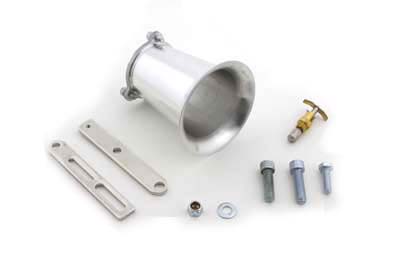

Functionally, anything you put at the stack entrance, filter-wise, upsets smooth airflow and negates any beneficial effect of the stack, aside from an aesthetic visual appeal for some individuals. That is where you appropriately run them open, and expect frequent engine overhauls. V stacks only have a place on the race track where your engine only has to last to the end of the race. The cost was several engines burned up as the engine went lean, as soon as air speed forced the ram air system to provide some denser air. Years ago, drag racers learned that if you pressurize the carb throats, you also have to pressurize the entire carb assembly, or at least the ports that supply the force that pushes the fuel through the carb jets. If you pressurize the carb float, air can flow backwards through the fuel jets into the carb bowl fuel reservior. Note the carb jets don't flow fuel when the engine doesn't run, and the carb throat pressure is the same as atmospheric. If you pressurize the carb throat with ram air, this increased pressure pushes back on the fuel flowing through the carb jets and leans the mixture. When the carb throat atmosphere is lowered by the engine sucking in air, the higher relative air pressure on the surface of the gas supply in the carb bowls pushes the fuel into the carb throat through the fuel jets, at a rate to provide the proper mixture for combustion.
It seems you have ignored how the carbs actually work.

Just a machinist with a wild imagination. The volume of the stacks would need to exceed the cylinder volume I am thinking.īut I am by no means an engineer. So If the air were being pulled fast enough(high rpm's) in a long enough tube, the air that is already moving at the end of the tubes would pressurize the carb end of the stacks. I know the scavenging effect of the exhaust is RPM dependent, as well as (basically) works by creating a vacuum at the precise time, unlike what I am thinking where things would be dependant on a positive pressure being built up by the incoming air.Ī object in motion tends to stay in motion unless a equal and opposite reaction occurs. I understand this would be a REALLY long velocity stack. Have the air build up pressure from being sucked at high velocity when have the intake valve shuts, allowing a "pulse" of air to be rammed into the cylinder as the intake valve opens up again?
VELOCITY STACK 4 MOD
The boost velocity is in the direction of the x-axis.You can get better flow with a filter, but would have to mod the airbox to accommodate a larger filter somehow.Īs the intake pulls on air, each carb flows the volume of air in the cylinder.Īs with exhaust pulses, and the scavenging effect.Ĭan you do the opposite on the intake side? Nevertheless, I believe my results here capture what you intended. perpendicular to the boost seems confused. The transformation laws of four-vectors are simple to learn, and the amount of manipulation needed to find the new three-velocity is minimal. To me, this is much simpler than churning through velocity-addition. These are algebraically the same as the formulas you posted in (a) and (b). Is there a way to connect 4-velocity to equations for adding speeds? I know 4-velocity $U^\mu$ is derived like this:


 0 kommentar(er)
0 kommentar(er)
